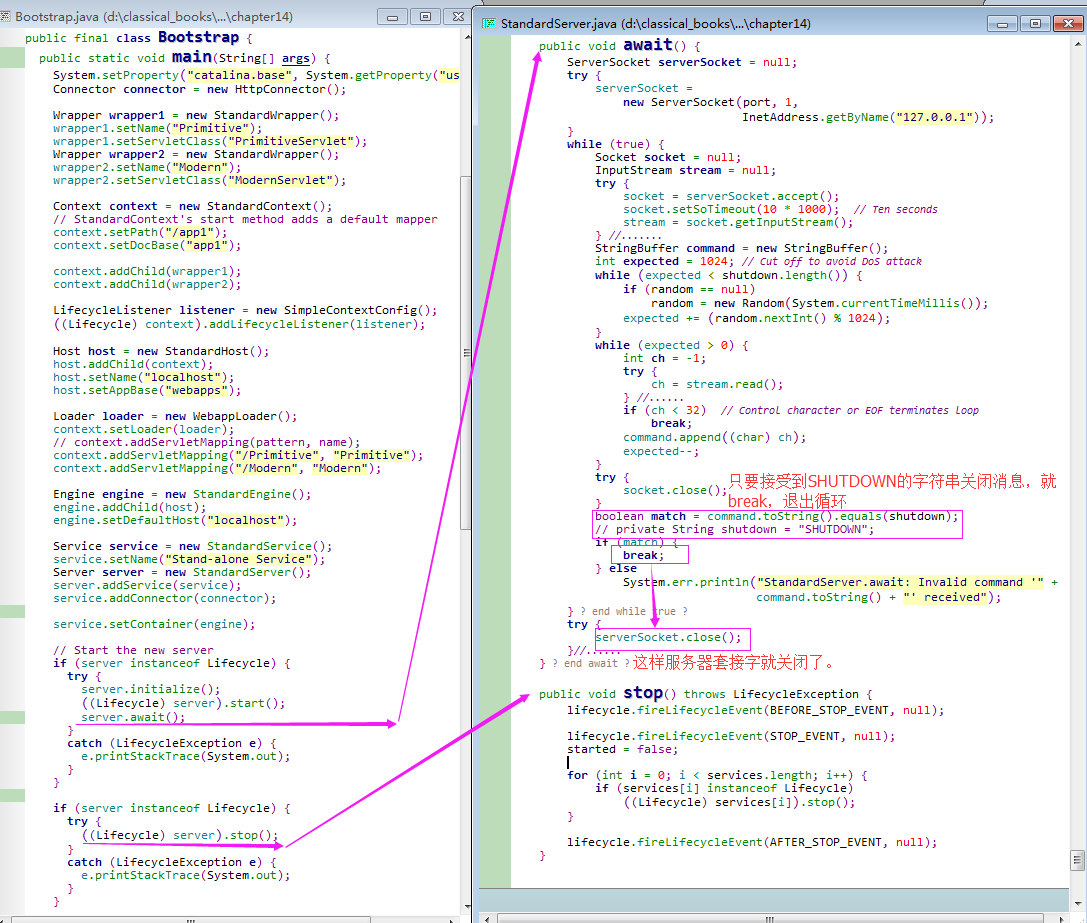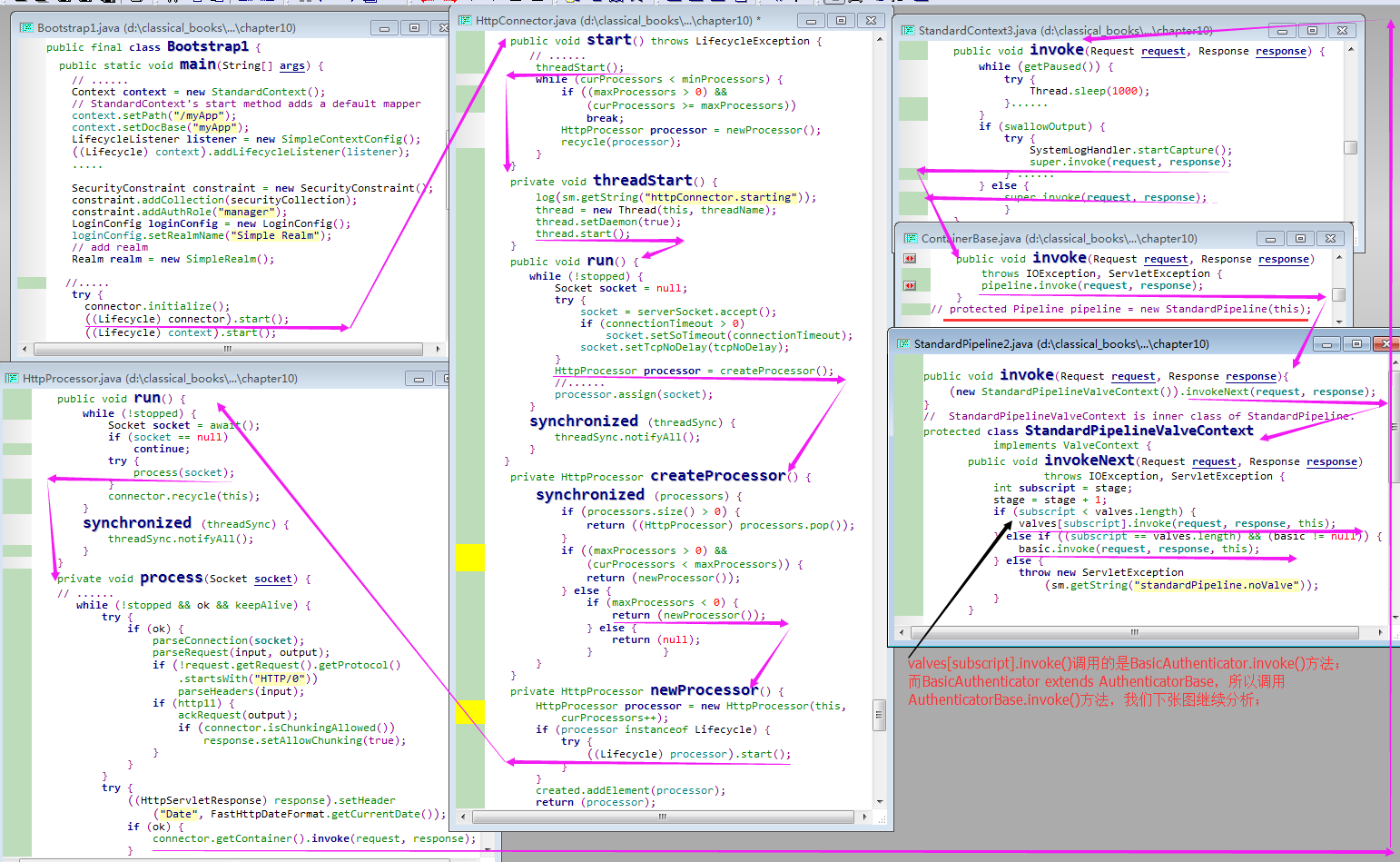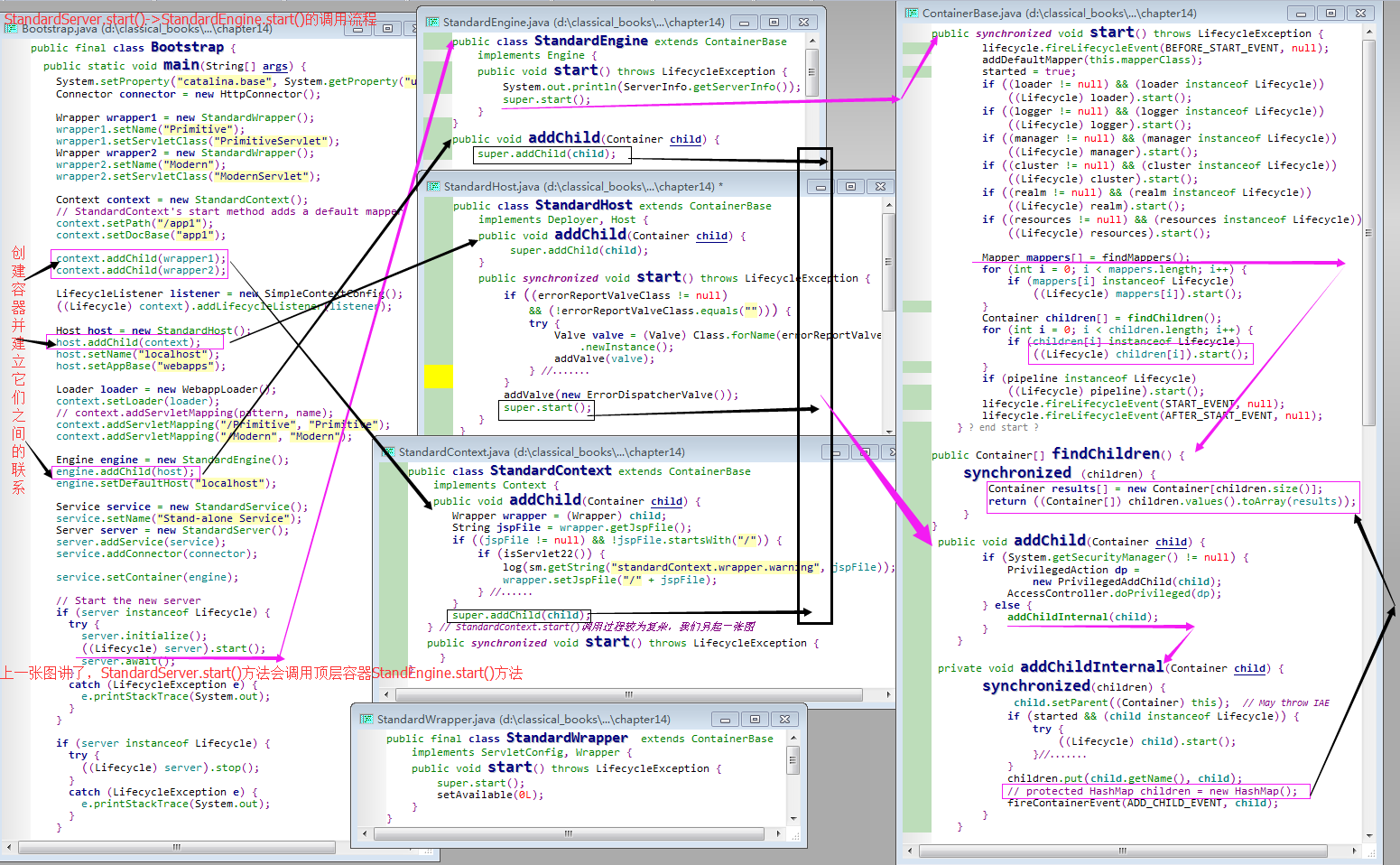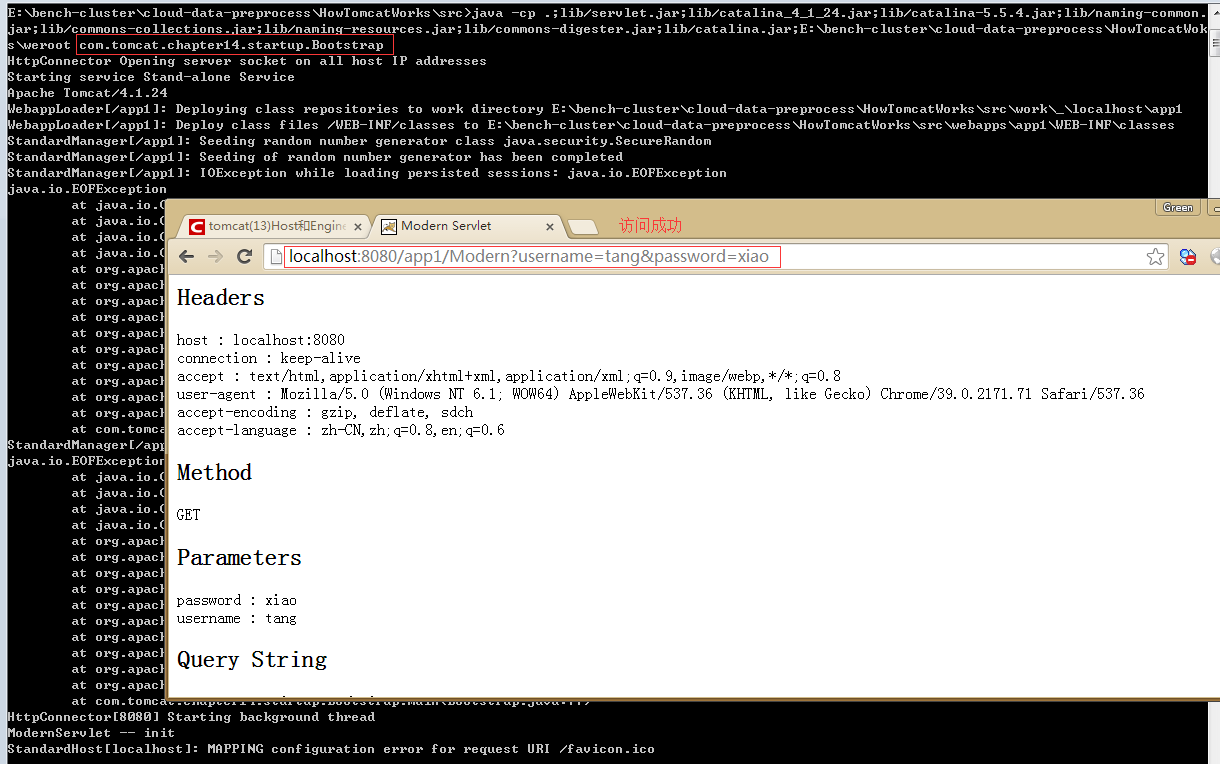【0】README
0.1)本文部分文字描述转自 “how tomcat works”,旨在学习 “tomcat(14)服务器组件和服务组件” 的基础知识;
0.2)for complete source code ,please visit https://github.com/pacosonTang/HowTomcatWorks/tree/master/chapter14
【1】服务器组件(org.apache.catalina.Server)
1)org.apache.catalina.Server接口的实例表示 Catalina的整个servlet引擎,囊括了所有的组件。服务器组件使用了一种优雅的方法来启动/关闭 整个系统,不需要再对连接器和容器分别启动/ 关闭;
2)启动/关闭机制的工作原理:当启动服务器组件时,它会启动其中所有的组件,然后它就无限期地等待关闭命令。如果想要关闭系统,可以向指定端口发送一条关闭命令。服务器组件接收到关闭命令后,就会关闭其中所有的组件;
3)服务组件:服务器组件引入了服务组件来包含其他组件,如一个容器组件和一个或多个连接器组件;(干货——注意区分服务器组件和服务组件,以下代码摘自某测试用例,StandardService表服务组件,而StandardServer表服务器组件)
Service service = new StandardService();service.setName("Stand-alone Service");Server server = new StandardServer();server.addService(service);4)服务器组件Server接口定义
package org.apache.catalina;
import org.apache.catalina.deploy.NamingResources;
public interface Server { public String getInfo();public NamingResources getGlobalNamingResources(); public void setGlobalNamingResources (NamingResources globalNamingResources); public int getPort(); public void setPort(int port); public String getShutdown(); public void setShutdown(String shutdown); public void addService(Service service); public void await(); public Service findService(String name); public Service[] findServices(); public void removeService(Service service);public void initialize() throws LifecycleException;
}对以上代码的分析(Analysis):
A1)shutdown属性:保存了必须发送给Server 实例用来关闭整个系统的关闭命令;A2)port属性:定义了服务器组件会从哪个端口获取关闭命令;A3)addService() 和 removeService()方法:为服务器组件添加或移除服务组件;A4)findService()方法:返回添加到该服务器组件中的所有服务组件;A5)initialize()方法:包含在系统启动前要执行的一些代码;
【2】StandardServer类
1)intro:一个服务器组件可以有0个或多个服务组件;(干货——一个服务器组件可以有0个或多个服务组件)
2)StandardServer类有4个与生命周期相关的方法,分别是initialize()方法,start()方法,stop()方法 和 await()方法;
【2.1】initialize()方法
1)intro:用于初始化添加到其中的服务器组件;
public void initialize() throws LifecycleException { //org.apache.catalina.StandardServer.initialize().if (initialized)throw new LifecycleException (sm.getString("standardServer.initialize.initialized"));initialized = true;// Initialize our defined Servicesfor (int i = 0; i < services.length; i++) {services[i].initialize();}}【2.2】start() 方法
1)intro:该方法用于启动服务器组件,即启动所有的服务组件,逐个启动所有组件,如连接器组件和servlet容器;
public void start() throws LifecycleException { //org.apache.catalina.StandardServer.start().// Validate and update our current component stateif (started)throw new LifecycleException(sm.getString("standardServer.start.started"));// Notify our interested LifecycleListenerslifecycle.fireLifecycleEvent(BEFORE_START_EVENT, null);lifecycle.fireLifecycleEvent(START_EVENT, null);started = true;// Start our defined Servicessynchronized (services) {for (int i = 0; i < services.length; i++) {if (services[i] instanceof Lifecycle)((Lifecycle) services[i]).start();}}// Notify our interested LifecycleListenerslifecycle.fireLifecycleEvent(AFTER_START_EVENT, null);}【2.3】stop()方法
1)intro:用于关闭服务器组件;(调用stop方法会关闭所有的服务组件,并reset started,这样,才能再次启动服务器组件;参见start()方法)
public void stop() throws LifecycleException { //org.apache.catalina.StandardServer.stop().// Validate and update our current component stateif (!started)throw new LifecycleException(sm.getString("standardServer.stop.notStarted"));// Notify our interested LifecycleListenerslifecycle.fireLifecycleEvent(BEFORE_STOP_EVENT, null);lifecycle.fireLifecycleEvent(STOP_EVENT, null);started = false;// Stop our defined Servicesfor (int i = 0; i < services.length; i++) {if (services[i] instanceof Lifecycle)((Lifecycle) services[i]).stop();}// Notify our interested LifecycleListenerslifecycle.fireLifecycleEvent(AFTER_STOP_EVENT, null);}【2.4】await()方法
1)intro:该方法负责等待关闭整个tomcat 部署的命令;
2)await()方法:调用该方法后,会一直阻塞,直到它从 8085 端口(也可以是其他端口)上接收到关闭命令(accept()方法);当await()方法返回时,会运行stop方法来关闭其下的所有子组件;
public void await() { //org.apache.catalina.StandardServer.await().// Set up a server socket to wait onServerSocket serverSocket = null;try {serverSocket =new ServerSocket(port, 1,InetAddress.getByName("127.0.0.1"));} catch (IOException e) {System.err.println("StandardServer.await: create[" + port+ "]: " + e);e.printStackTrace();System.exit(1);}// Loop waiting for a connection and a valid commandwhile (true) {// Wait for the next connectionSocket socket = null;InputStream stream = null;try {socket = serverSocket.accept(); //highlight line.socket.setSoTimeout(10 * 1000); // Ten secondsstream = socket.getInputStream();} catch (AccessControlException ace) {System.err.println("StandardServer.accept security exception: "+ ace.getMessage());continue;} catch (IOException e) {System.err.println("StandardServer.await: accept: " + e);e.printStackTrace();System.exit(1);}// Read a set of characters from the socketStringBuffer command = new StringBuffer();int expected = 1024; // Cut off to avoid DoS attackwhile (expected < shutdown.length()) {if (random == null)random = new Random(System.currentTimeMillis());expected += (random.nextInt() % 1024);}while (expected > 0) {int ch = -1;try {ch = stream.read();} catch (IOException e) {System.err.println("StandardServer.await: read: " + e);e.printStackTrace();ch = -1;}if (ch < 32) // Control character or EOF terminates loopbreak;command.append((char) ch);expected--;}// Close the socket now that we are done with ittry {socket.close();} catch (IOException e) {;}// Match against our command stringboolean match = command.toString().equals(shutdown); //highlight line.if (match) {break;} elseSystem.err.println("StandardServer.await: Invalid command '" +command.toString() + "' received");}// Close the server socket and returntry {serverSocket.close();} catch (IOException e) {;}}对以上代码的调用过程分析(steps):
step1)创建一个ServerSocket对象,监听8085端口,并在while循环中调用它的accept()方法;step2)当在指定端口上接收到消息时,accept()方法才会返回;step3)将接收到的消息与关闭命令的字符串相比较,相同的话就跳出while循环,关闭 ServerSocket,否则会再次循环,继续等待消息;
【3】Service接口(服务组件接口——org.apache.catalina.core.Service)
1)intro:一个服务组件可以有一个servlet容器 和 多个连接器实例;(干货——一个服务器组件可以有0个或多个服务组件,而一个服务组件可以有一个servlet容器 和 多个连接器实例)
2)可以自由地把连接器添加到服务组件中,所有的连接器都会与这个servlet容器相关联;
package org.apache.catalina;
public interface Service { public Container getContainer(); public void setContainer(Container container); public String getInfo(); public String getName(); public void setName(String name); public Server getServer(); public void setServer(Server server); public void addConnector(Connector connector); public Connector[] findConnectors(); public void removeConnector(Connector connector); public void initialize() throws LifecycleException;
}【4】StandardService类(org.apache.catalina.core.StandardService)
1)StandardService.initialize()方法:用于初始化添加到其中的所有连接器;2)StandardService.start()方法:启动连接器和所有servlet容器;
【4.1】connectors 和 container
1)StandardService实例中有两种组件:连接器和servlet容器;其中servlet容器只有一个,而连接器则可以有多个;(干货——StandardService实例中有两种组件:连接器和servlet容器)
2)多个连接器使tomcat 可以为多种不同的请求协议提供服务;如,一个连接器处理HTTP请求,而另一个连接器处理HTTPS请求;(干货——多个连接器使tomcat 可以为多种不同的请求协议提供服务)
3)变量connectors 和 container:StandardService类使用 container 变量来指向一个Container接口的实例,而数组connectors 来保存所有连接器的引用;(干货——变量connectors 和 container的用途)
private Connector connectors[] = new Connector[0]; // defined in StandardService.4)setContainer()方法:需要调用setContainer()方法 将servlet容器与服务组件相关联;
public void setContainer(Container container) { // org.apache.catalina.core.StandardService.setContainer().Container oldContainer = this.container;if ((oldContainer != null) && (oldContainer instanceof Engine))((Engine) oldContainer).setService(null);this.container = container;if ((this.container != null) && (this.container instanceof Engine))((Engine) this.container).setService(this);if (started && (this.container != null) &&(this.container instanceof Lifecycle)) {try {((Lifecycle) this.container).start();} catch (LifecycleException e) {;}}synchronized (connectors) {for (int i = 0; i < connectors.length; i++)connectors[i].setContainer(this.container);}if (started && (oldContainer != null) &&(oldContainer instanceof Lifecycle)) {try {((Lifecycle) oldContainer).stop();} catch (LifecycleException e) {;}}// Report this property change to interested listenerssupport.firePropertyChange("container", oldContainer, this.container);}对以上代码的补充描述(description):与服务组件相关联的servlet容器的实例将被传给每个连接器对象的 setContainer()方法,这样在服务组件中就可以形成每个连接器和 servlet容器间的关联关系;
5)addConnector()方法和removeConnector()方法:前者将连接器添加到服务组件中, 后者将某个连接器移除;
(补充:addConnector()方法会初始化并启动添加到其中的连接器,参见下面的start()方法——highlight line.)
public void addConnector(Connector connector) { //org.apache.catalina.core.StandardService.addConnector().synchronized (connectors) {connector.setContainer(this.container);connector.setService(this);Connector results[] = new Connector[connectors.length + 1];System.arraycopy(connectors, 0, results, 0, connectors.length);results[connectors.length] = connector;connectors = results;if (initialized) {try {connector.initialize(); //highlight line.} catch (LifecycleException e) {e.printStackTrace(System.err);}}if (started && (connector instanceof Lifecycle)) {try {((Lifecycle) connector).start();//highlight line.} catch (LifecycleException e) {;}}// Report this property change to interested listenerssupport.firePropertyChange("connector", null, connector);}}
public void removeConnector(Connector connector) { //org.apache.catalina.core.StandardService.removeConnector().synchronized (connectors) {int j = -1;for (int i = 0; i < connectors.length; i++) {if (connector == connectors[i]) {j = i;break;}}if (j < 0)return;if (started && (connectors[j] instanceof Lifecycle)) {try {((Lifecycle) connectors[j]).stop();} catch (LifecycleException e) {;}}connectors[j].setContainer(null);connector.setService(null);int k = 0;Connector results[] = new Connector[connectors.length - 1];for (int i = 0; i < connectors.length; i++) {if (i != j)results[k++] = connectors[i];}connectors = results;// Report this property change to interested listenerssupport.firePropertyChange("connector", connector, null);}}【4.2】与生命周期有关的方法(start() + stop() + initialize())
1)intro: 与生命周期有关的方法包括Lifecycle.start() + Lifecycle.stop()+ initialize()方法;其中initialize()方法会调用该服务组件中所有连接器的 initialize()方法;
2)org.apache.catalina.core.StandardService.initialize()源码如下:
public void initialize() throws LifecycleException { //org.apache.catalina.core.StandardService.initialize().if (initialized) throw new LifecycleException (sm.getString("standardService.initialize.initialized"));initialized = true;// Initialize our defined Connectorssynchronized (connectors) {for (int i = 0; i < connectors.length; i++) {connectors[i].initialize(); //highlight line.}}}
public void initialize() throws LifecycleException { //org.apache.catalina.connector.HttpConnector.initialize().if (initialized)throw new LifecycleException (sm.getString("httpConnector.alreadyInitialized"));this.initialized=true;Exception eRethrow = null;// Establish a server socket on the specified porttry {serverSocket = open();} catch (IOException ioe) {log("httpConnector, io problem: ", ioe);eRethrow = ioe;} catch (KeyStoreException kse) {log("httpConnector, keystore problem: ", kse);eRethrow = kse;} catch (NoSuchAlgorithmException nsae) {log("httpConnector, keystore algorithm problem: ", nsae);eRethrow = nsae;} catch (CertificateException ce) {log("httpConnector, certificate problem: ", ce);eRethrow = ce;} catch (UnrecoverableKeyException uke) {log("httpConnector, unrecoverable key: ", uke);eRethrow = uke;} catch (KeyManagementException kme) {log("httpConnector, key management problem: ", kme);eRethrow = kme;}if ( eRethrow != null )throw new LifecycleException(threadName + ".open", eRethrow);}3)org.apache.catalina.core.StandardService.start()源码如下:该方法负责启动被添加到 该服务组件中的连接器和servlet容器;
public void start() throws LifecycleException { // org.apache.catalina.core.StandardService.start()// Validate and update our current component stateif (started) {throw new LifecycleException(sm.getString("standardService.start.started"));}// Notify our interested LifecycleListenerslifecycle.fireLifecycleEvent(BEFORE_START_EVENT, null);System.out.println(sm.getString("standardService.start.name", this.name));lifecycle.fireLifecycleEvent(START_EVENT, null);started = true;// Start our defined Container firstif (container != null) {synchronized (container) {if (container instanceof Lifecycle) {((Lifecycle) container).start(); //highlight line.}}}// Start our defined Connectors secondsynchronized (connectors) {for (int i = 0; i < connectors.length; i++) {if (connectors[i] instanceof Lifecycle)((Lifecycle) connectors[i]).start(); //highlight line.}}// Notify our interested LifecycleListenerslifecycle.fireLifecycleEvent(AFTER_START_EVENT, null);}4)org.apache.catalina.core.StandardService.stop()源码如下:用于关闭与该服务组件相关联的servlet容器和所有连接器;
public void stop() throws LifecycleException { // org.apache.catalina.core.StandardService.stop()// Validate and update our current component stateif (!started) {throw new LifecycleException(sm.getString("standardService.stop.notStarted"));}// Notify our interested LifecycleListenerslifecycle.fireLifecycleEvent(BEFORE_STOP_EVENT, null);lifecycle.fireLifecycleEvent(STOP_EVENT, null);System.out.println(sm.getString("standardService.stop.name", this.name));started = false;// Stop our defined Connectors firstsynchronized (connectors) {for (int i = 0; i < connectors.length; i++) {if (connectors[i] instanceof Lifecycle)((Lifecycle) connectors[i]).stop();//highlight line.}}// Stop our defined Container secondif (container != null) {synchronized (container) {if (container instanceof Lifecycle) {((Lifecycle) container).stop(); //highlight line.}}}// Notify our interested LifecycleListenerslifecycle.fireLifecycleEvent(AFTER_STOP_EVENT, null);}【5】应用程序
1)intro:本应用程序旨在说明如何使用服务器组件和服务组件,特别是在 StandardServer类中如何利用 启动和关闭机制;
2)共有3个类:Bootstrap类+Stopper类+SimpleContextConfig类(它其实是作为 LifecycleListener的实例)
2.1)Bootstrap类源码
public final class Bootstrap {public static void main(String[] args) {System.setProperty("catalina.base", System.getProperty("user.dir"));Connector connector = new HttpConnector();Wrapper wrapper1 = new StandardWrapper();wrapper1.setName("Primitive");wrapper1.setServletClass("PrimitiveServlet");Wrapper wrapper2 = new StandardWrapper();wrapper2.setName("Modern");wrapper2.setServletClass("ModernServlet");Context context = new StandardContext();// StandardContext's start method adds a default mappercontext.setPath("/app1");context.setDocBase("app1");context.addChild(wrapper1);context.addChild(wrapper2);LifecycleListener listener = new SimpleContextConfig();((Lifecycle) context).addLifecycleListener(listener);Host host = new StandardHost();host.addChild(context);host.setName("localhost");host.setAppBase("webapps");Loader loader = new WebappLoader();context.setLoader(loader);// context.addServletMapping(pattern, name);context.addServletMapping("/Primitive", "Primitive");context.addServletMapping("/Modern", "Modern");Engine engine = new StandardEngine();engine.addChild(host);engine.setDefaultHost("localhost");Service service = new StandardService();service.setName("Stand-alone Service");Server server = new StandardServer();server.addService(service);service.addConnector(connector);//StandardService class's setContainer will call all its connector's setContainer methodservice.setContainer(engine);// Start the new serverif (server instanceof Lifecycle) {try {server.initialize();((Lifecycle) server).start();server.await();// the program waits until the await method returns,// i.e. until a shutdown command is received.}catch (LifecycleException e) {e.printStackTrace(System.out);}}// Shut down the serverif (server instanceof Lifecycle) {try {((Lifecycle) server).stop();}catch (LifecycleException e) {e.printStackTrace(System.out);}}}
}对以上代码的调用过程分析(steps):
step1)该方法会创建一个连接器,两个Wrapper实例,一个Context容器,一个Host容器和一个Engine容器;step2)将两个Wrapper 实例添加到 Context容器中, 将Context容器添加到 Host容器中,再将Host容器添加到Engine容器中;(干货——到此,tomcat的4种容器创建完毕)step3)但是,这并没有将连接器和最顶层的容器Engine相关联;step4)相反,main()方法创建了一个Service对象,设置其名称,再创建一个 Server对象,将Service实例添加到 Server实例中:Service service = new StandardService();service.setName("Stand-alone Service");Server server = new StandardServer();server.addService(service);step5)main()方法将连接器和Engine容器添加到 Service实例中;service.addConnector(connector);service.setContainer(engine);step6)main()方法调用 Server.intialize() 和 Server.start()方法,初始化连接器,并启动连接器和servlet容器;step7)接下来,main()方法调用Server.await()方法,进入循环等待,监听8085端口等待关闭命令;(干货——参见上述【2.4】await()方法)
Attention)此时连接器已经处于运行状态,等待另一个端口8080上的 http 请求;(监听8085和8080端口分别处于不同的线程)
// Start the new serverif (server instanceof Lifecycle) {try {server.initialize(); // step6((Lifecycle) server).start(); // step6server.await(); // step7// the program waits until the await method returns,// i.e. until a shutdown command is received.}catch (LifecycleException e) {e.printStackTrace(System.out);}}step8)除非收到了正确的关闭命令,否则await()方法是不会返回的。当 await()方法返回时,main()方法调用 Server.stop()方法,实际上关闭其所有组件;// Shut down the serverif (server instanceof Lifecycle) {try {((Lifecycle) server).stop();}catch (LifecycleException e) {e.printStackTrace(System.out);}}
2.2)Stopper类 源码
2.2.1)intro:Stopper类提供了更加优雅的方式来关闭Catalina服务器,也保证了所有的生命周期组件中的stop() 方法都能够调用;
public class Stopper {public static void main(String[] args) {// the following code is taken from the Stop method of// the org.apache.catalina.startup.Catalina classint port = 8005;try {Socket socket = new Socket("127.0.0.1", port);OutputStream stream = socket.getOutputStream();String shutdown = "SHUTDOWN";for (int i = 0; i < shutdown.length(); i++)stream.write(shutdown.charAt(i));stream.flush();stream.close();socket.close();System.out.println("The server was successfully shut down.");}catch (IOException e) {System.out.println("Error. The server has not been started.");}}
}对以上代码的分析(Analysis): Stopper类的main()方法会创建一个 Socket对象,然后将正确 的关闭命令 “SHOTDOWN”字符串发送到 端口8085。Catalina 服务器在接收到关闭命令后,就会执行相应的关闭操作;
Attention)本文还是习惯性地总结了上述测试用例的调用流程图


A1)HttpConnector.start()方法的调用过程如下(下面的图借用自 tomcat(11) 中章节【1】的4.1小节的图):

A2)StandardsEngine.start()方法的调用过程如下(下面的第二张图借用自tomcat(13)中的章节【10】 ,两张图可以结合起来看):

(补充,需要了解 HttpConnector.initialize() 和 start() 方法 以及 StandardContext.start()方法的具体调用过程,参见 tomcat(supplement)HttpConnector.initialize() 和 start() 方法 以及 StandardContext.start()方法的分析)

【6】执行结果
1)console info
E:\bench-cluster\cloud-data-preprocess\HowTomcatWorks\src>java -cp .;lib/servlet.jar;lib/catalina_4_1_24.jar;lib/catalina-5.5.4.jar;lib/naming-common.
jar;lib/commons-collections.jar;lib/naming-resources.jar;lib/commons-digester.jar;lib/catalina.jar;E:\bench-cluster\cloud-data-preprocess\HowTomcatWok
s\weroot com.tomcat.chapter14.startup.Bootstrap
HttpConnector Opening server socket on all host IP addresses
Starting service Stand-alone Service
Apache Tomcat/4.1.24
WebappLoader[/app1]: Deploying class repositories to work directory E:\bench-cluster\cloud-data-preprocess\HowTomcatWorks\src\work\_\localhost\app1
WebappLoader[/app1]: Deploy class files /WEB-INF/classes to E:\bench-cluster\cloud-data-preprocess\HowTomcatWorks\src\webapps\app1\WEB-INF\classes
StandardManager[/app1]: Seeding random number generator class java.security.SecureRandom
StandardManager[/app1]: Seeding of random number generator has been completed
StandardManager[/app1]: IOException while loading persisted sessions: java.io.EOFException
java.io.EOFExceptionat java.io.ObjectInputStream$PeekInputStream.readFully(Unknown Source)at java.io.ObjectInputStream$BlockDataInputStream.readShort(Unknown Source)at java.io.ObjectInputStream.readStreamHeader(Unknown Source)at java.io.ObjectInputStream.<init>(Unknown Source)at org.apache.catalina.util.CustomObjectInputStream.<init>(CustomObjectInputStream.java:103)at org.apache.catalina.session.StandardManager.load(StandardManager.java:408)at org.apache.catalina.session.StandardManager.start(StandardManager.java:655)at org.apache.catalina.core.StandardContext.start(StandardContext.java:3570)at org.apache.catalina.core.ContainerBase.start(ContainerBase.java:1188)at org.apache.catalina.core.StandardHost.start(StandardHost.java:738)at org.apache.catalina.core.ContainerBase.start(ContainerBase.java:1188)at org.apache.catalina.core.StandardEngine.start(StandardEngine.java:347)at org.apache.catalina.core.StandardService.start(StandardService.java:497)at org.apache.catalina.core.StandardServer.start(StandardServer.java:2190)at com.tomcat.chapter14.startup.Bootstrap.main(Bootstrap.java:77)
StandardManager[/app1]: Exception loading sessions from persistent storage
java.io.EOFExceptionat java.io.ObjectInputStream$PeekInputStream.readFully(Unknown Source)at java.io.ObjectInputStream$BlockDataInputStream.readShort(Unknown Source)at java.io.ObjectInputStream.readStreamHeader(Unknown Source)at java.io.ObjectInputStream.<init>(Unknown Source)at org.apache.catalina.util.CustomObjectInputStream.<init>(CustomObjectInputStream.java:103)at org.apache.catalina.session.StandardManager.load(StandardManager.java:408)at org.apache.catalina.session.StandardManager.start(StandardManager.java:655)at org.apache.catalina.core.StandardContext.start(StandardContext.java:3570)at org.apache.catalina.core.ContainerBase.start(ContainerBase.java:1188)at org.apache.catalina.core.StandardHost.start(StandardHost.java:738)at org.apache.catalina.core.ContainerBase.start(ContainerBase.java:1188)at org.apache.catalina.core.StandardEngine.start(StandardEngine.java:347)at org.apache.catalina.core.StandardService.start(StandardService.java:497)at org.apache.catalina.core.StandardServer.start(StandardServer.java:2190)at com.tomcat.chapter14.startup.Bootstrap.main(Bootstrap.java:77)
HttpConnector[8080] Starting background thread
ModernServlet -- init
StandardHost[localhost]: MAPPING configuration error for request URI /favicon.ico2)执行效果




Digester库)


intro)


线程安全性)

关闭钩子)


启动tomcat)

Spring之旅)


装配Bean)
